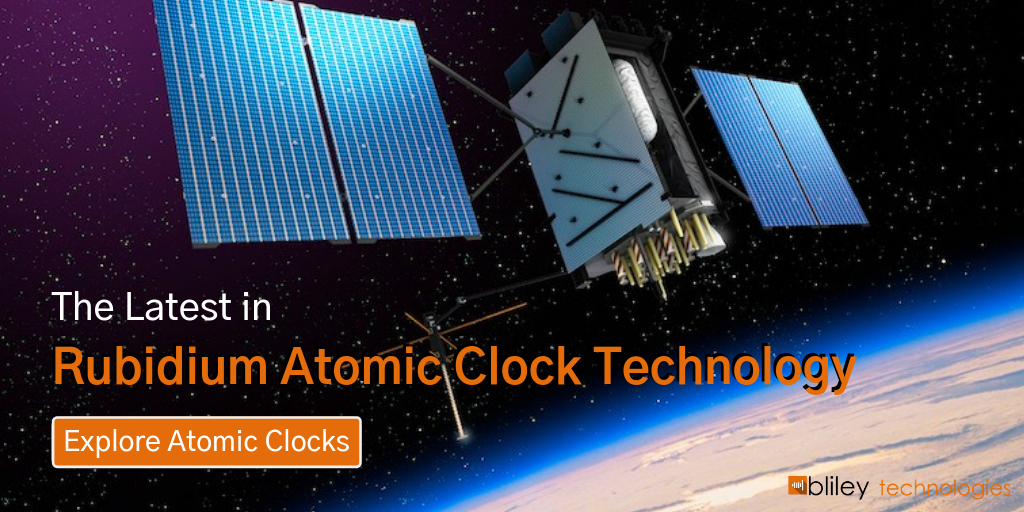
Do you know all about atomic clocks in space and how they work? If not, it's about TIME you do. (Haha. Ha. Ha...)
Timing is everything when it comes to GPS satellites and other space applications. Even just a one-microsecond error in timing can lead to an error of 300 meters on the ground. Because atomic clocks can maintain very precise timing, they're a great solution for GPS and other LEO satellites.
What Are Atomic Clocks?
While pendulums are used as the frequency reference in analog clocks, atomic clocks are a more precise frequency reference.
At the core of an atomic clock is a quartz crystal. Quartz crystals produce a very specific frequency pulse (similar to the swinging of a pendulum) when a voltage is applied to the crystal. The desired output frequency produced by the crystal depends on how the quartz is cut and manufactured.
Quartz crystals and quartz crystal oscillators are used in a huge variety of applications from cell phones to high-end military & PNT equipment. But the frequency produced by a quartz crystal or crystal oscillator alone isn't typically precise enough when it comes to GNSS & GPS satellite constellation standards, because they will still slowly lose track of time. An upgraded strategy was needed to help create the super-accurate atomic clocks used today.

Related: Should I Use a GPSDO or Atomic Clock in my Satellite Application?
Atomic Clock Frequency
Physicists discovered that atoms of specific elements oscillated at exactly the same rate. In 1967, the atomic clock timing standard was determined to be exactly 9,192,631,770 oscillations per second (Cesium 133 atom resonant frequency).
When applying radio waves with the exact same frequency as the cesium, it begins to resonate and swings the atoms into a higher energy state. This is similar to when an opera singer sings a specific high note that causes a glass to resonate and then shatter.

The idea was to use this heightened energy state to indicate that the radio wave frequency was exactly right. So using the quartz crystal's resonance, the frequency pulses it produces are used to determine the frequency of a radio wave transmitter (in hertz, a.k.a. "waves per second").
Just like counting the number of electrical pulses in a quartz crystal clock, an atomic clock will count the number of frequency waves to determine a very accurate second. For example, if a piece of quartz resonates at 33,138 times per second, the radio transmitter will transmit a frequency of 33,138 Hz. When the same number of waves are counted from the radio transmitter, we know that a second has passed.
How Do Atomic Clocks Work?
Maintaining the same frequency over time is very difficult. This is because the frequency of quartz can deviate based on changes in environmental factors, such as vibration, temperature, and g-forces. Sometimes, a high-quality, ultra-stable crystal oscillator can help maintain a crystal's desired frequency, but atomic clocks typically make use of cesium atoms.
The flow of higher-energy-state cesium atoms are detected by a sensor in the atomic clock. If the radio wave frequency is exact, cesium atoms will continue to flow through the sensor at their peak rate.
But if the frequency isn't exactly right, fewer cesium atoms are determined by the sensor. In this case, a jolt of electricity is sent to the quartz oscillator that alters the frequency to make it just right for a correct resonating rate of cesium atoms. This process is known as a feedback loop. This essentially makes atomic clocks self-correcting.
What Are the Types of Atomic Clocks?
Atoms of specific elements are used in atomic clocks for different requirements. The 3 types of atomic clocks include cesium, hydrogen, and rubidium.
Cesium Atomic Clocks - As discussed above, cesium atomic clocks employ a beam of cesium atoms. The clock separates cesium atoms of different energy levels by a magnetic field.
Hydrogen atomic clocks - This type of atomic clock maintains hydrogen atoms at the required energy level by using a container with walls of a special material to keep the atoms from losing their higher energy state too quickly.
Rubidium Atomic Clocks - These are the simplest and most compact of all atomic clocks. They use a glass cell of rubidium gas that changes its absorption of light at the optical rubidium frequency when the surrounding microwave frequency is just right.
Bliley's Rubidium Atomic Clocks
Here at Bliley, we've combined our 85+ years of quartz crystal and oscillator manufacturing with AccuBeat to create the AR133 Rubidium Atomic Clock. The AR133 is designed to provide precision timing and frequency beyond what is typically available from quartz oscillators.
Download our full AR133 atomic clock datasheet to learn more!






